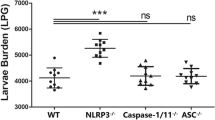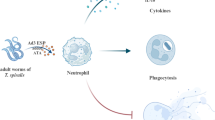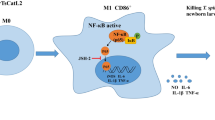Abstract
Trichinella spiralis is a foodborne zoonotic nematode, which causes trichinellosis. During the infection, parasite evades the host immune responses by direct and indirect (through excretory-secretory products) contact with host immune cells. One of the main targets for immunomodulation induced by helminths are macrophages. In this study, we examined whether direct contact of different stages of T. spiralis can affect the polarization of human THP-1 macrophages. Co-culture of adult parasite stage and cells in direct contact without LPS addition had a significant impact on TNFα levels. Interestingly, in settings with the addition of LPS, the levels of IL-1β and TNFα significantly increased in adult parasite and newborn larvae (NBL) but not for muscle larvae (ML). While we tested muscle larvae ESP products to compare its effect with whole ML parasite, we detect an increase of pro-inflammatory cytokines like IL-1β and TNFα in no LPS conditions. Whereas, muscle larvae ESP significantly suppressed the inflammatory response measured by IL-1β, TNFα, and IL-6 levels and anti-inflammatory IL-10 compared to LPS control. Our findings indicate the anti-inflammatory potential of T. spiralis muscle larvae excretory-secretory products and propose signaling pathways which might be engaged in the mechanism of how muscle larvae ESP affect human macrophages.



Similar content being viewed by others
Data availability
The data that support the findings of this study are available from the corresponding author upon reasonable request.
References
Aranzamendi C et al (2012) Trichinella spiralis-secreted products modulate DC functionality and expand regulatory T cells in vitro parasite. Immunol 34:210–223. https://doi.org/10.1111/j.1365-3024.2012.01353.x
Arthur JS, Ley SC (2013) Mitogen-activated protein kinases in innate immunity. Nat Rev Immunol 13:679–692. https://doi.org/10.1038/nri3495
Bai X et al (2012) Regulation of cytokine expression in murine macrophages stimulated by excretory/secretory products from Trichinella spiralis in vitro. Mol Cell Biochem 360:79–88. https://doi.org/10.1007/s11010-011-1046-4
Baska P, Wisniewski M, Krzyzowska M, Dlugosz E, Zygner W, Gorski P, Wedrychowicz H (2013) Molecular cloning and characterisation of in vitro immune response against astacin-like metalloprotease Ace-MTP-2 from Ancylostoma ceylanicum. Exp Parasitol 133:472–482. https://doi.org/10.1016/j.exppara.2013.01.006
Beiting DP, Bliss SK, Schlafer DH, Roberts VL, Appleton JA (2004) Interleukin-10 limits local and body cavity inflammation during infection with muscle-stage Trichinella spiralis. Infect Immun 72:3129–3137. https://doi.org/10.1128/IAI.72.6.3129-3137.2004
Blumenthal A et al (2006) The wingless homolog WNT5A and its receptor Frizzled-5 regulate inflammatory responses of human mononuclear cells induced by microbial stimulation. Blood 108:965–973. https://doi.org/10.1182/blood-2005-12-5046
Bruschi F (2002) The immune response to the parasitic nematode Trichinella and the ways to escape it. From experimental studies to implications for human infection. Curr Drug Targets Immune Endocr Metabol Disord 2:269–280. https://doi.org/10.2174/1568008023340523
Chawla A (2010) Control of macrophage activation and function by PPARs. Circ Res 106:1559–1569. https://doi.org/10.1161/CIRCRESAHA.110.216523
Chen Y, Huang B, Huang S, Yu X, Li Y, Song W, Lu F (2013) Coinfection with Clonorchis sinensis modulates murine host response against Trichinella spiralis infection. Parasitol Res 112:3167–3179. https://doi.org/10.1007/s00436-013-3493-1
Chen YJ, Hsu CC, Shiao YJ, Wang HT, Lo YL, Lin AMY (2019) Anti-inflammatory effect of afatinib (an EGFR-TKI) on OGD-induced neuroinflammation. Sci Rep 9:2516. https://doi.org/10.1038/s41598-019-38676-7
Cvetkovic J, Ilic N, Sofronic-Milosavljevic L, Gruden-Movsesijan A (2014) Glycans expressed on Trichinella spiralis excretory-secretory antigens are important for anti-inflamatory immune response polarization. Comp Immunol Microbiol Infect Dis 37:355–367. https://doi.org/10.1016/j.cimid.2014.10.004
Ding J, Bai X, Wang X, Shi H, Cai X, Luo X, Liu M, Liu X (2017) Immune cell responses and cytokine profile in intestines of mice infected with Trichinella spiralis. Front Microbiol 8:2069. https://doi.org/10.3389/fmicb.2017.02069
Dlugosz E, Basalaj K, Zawistowska-Deniziak A (2019) Cytokine production and signalling in human THP-1 macrophages is dependent on Toxocara canis glycans. Parasitol Res 118:2925-2933 doi:https://doi.org/10.1007/s00436-019-06405-8
Du L, Liu L, Yu Y, Shan H, Li L (2014) Trichinella spiralis excretory-secretory products protect against polymicrobial sepsis by suppressing MyD88 via mannose receptor. Biomed Res Int 2014:898646. https://doi.org/10.1155/2014/898646
Gruden-Movsesijan A, Ilic N, Colic M, Majstorovic I, Vasilev S, Radovic I, Sofronic-Milosavljevic L (2011) The impact of Trichinella spiralis excretory-secretory products on dendritic cells. Comp Immunol Microbiol Infect Dis 34:429–439. https://doi.org/10.1016/j.cimid.2011.08.004
Halleskog C, Schulte G (2013) WNT-3A and WNT-5A counteract lipopolysaccharide-induced pro-inflammatory changes in mouse primary microglia. J Neurochem 125:803–808. https://doi.org/10.1111/jnc.12250
Hazeki K, Nigorikawa K, Hazeki O (2007) Role of phosphoinositide 3-kinase in innate immunity. Biol Pharm Bull 30:1617–1623. https://doi.org/10.1248/bpb.30.1617
Ilic N, Colic M, Gruden-movsesijan A, Majstorovic I, Vasilev S, Sofronic-Milosavljevic L (2008) Characterization of rat bone marrow dendritic cells initially primed by Trichinella spiralis antigens. Parasite Immunol 30:491–495. https://doi.org/10.1111/j.1365-3024.2008.01049.x
Ilic N et al (2018) Trichinella spiralis excretory-secretory products induce tolerogenic properties in human dendritic cells via toll-like receptors 2 and 4. Front Immunol 9:11. https://doi.org/10.3389/fimmu.2018.00011
Jaguin M, Houlbert N, Fardel O, Lecureur V (2013) Polarization profiles of human M-CSF-generated macrophages and comparison of M1-markers in classically activated macrophages from GM-CSF and M-CSF origin. Cell Immunol 281:51–61. https://doi.org/10.1016/j.cellimm.2013.01.010
Johnston MJ, Wang A, Catarino ME, Ball L, Phan VC, MacDonald JA, McKay DM (2010) Extracts of the rat tapeworm, Hymenolepis diminuta, suppress macrophage activation in vitro and alleviate chemically induced colitis in mice. Infect Immun 78:1364–1375. https://doi.org/10.1128/IAI.01349-08
Kang SA, Park MK, Park SK, Choi JH, Lee DI, Song SM, Yu HS (2019) Adoptive transfer of Trichinella spiralis-activated macrophages can ameliorate both Th1- and Th2-activated inflammation in murine models. Sci Rep 9:6547. https://doi.org/10.1038/s41598-019-43057-1
Kapel CM, Gamble HR (2000) Infectivity, persistence, and antibody response to domestic and sylvatic Trichinella spp. in experimentally infected pigs. Int J Parasitol 30:215–221. https://doi.org/10.1016/s0020-7519(99)00202-7
Kazyken D et al. (2019) AMPK directly activates mTORC2 to promote cell survival during acute energetic stress. Sci Signal 12 https://doi.org/10.1126/scisignal.aav3249
Kelly B, O’Neill LA (2015) Metabolic reprogramming in macrophages and dendritic cells in innate immunity. Cell Res 25:771–784. https://doi.org/10.1038/cr.2015.68
Khan WI, Collins SM (2004) Immune-mediated alteration in gut physiology and its role in host defence in nematode infection. Parasite Immunol 26:319–326. https://doi.org/10.1111/j.0141-9838.2004.00715.x
Langelaar M, Aranzamendi C, Franssen F, Van Der Giessen J, Rutten V, van der Ley P, Pinelli E (2009) Suppression of dendritic cell maturation by Trichinella spiralis excretory/secretory products. Parasite Immunol 31:641–645. https://doi.org/10.1111/j.1365-3024.2009.01136.x
Lee YG, Lee J, Byeon SE, Yoo DS, Kim MH, Lee SY, Cho JY (2011) Functional role of Akt in macrophage-mediated innate immunity. Front Biosci (Landmark Ed) 16:517–530. https://doi.org/10.2741/3702
Lee H, Bae S, Choi BW, Yoon Y (2012) WNT/beta-catenin pathway is modulated in asthma patients and LPS-stimulated RAW264.7 macrophage cell line. Immunopharmacol Immunotoxicol 34:56–65. https://doi.org/10.3109/08923973.2011.574704
Leto SM, Trusolino L (2014) Primary and acquired resistance to EGFR-targeted therapies in colorectal cancer: impact on future treatment strategies. J Mol Med (Berl) 92:709–722. https://doi.org/10.1007/s00109-014-1161-2
Loukas A, Hotez PJ, Diemert D, Yazdanbakhsh M, McCarthy JS, Correa-Oliveira R, Croese J, Bethony JM (2016) Hookworm infection. Nat Rev Dis Primers 2:16088. https://doi.org/10.1038/nrdp.2016.88
Maess MB, Sendelbach S, Lorkowski S (2010) Selection of reliable reference genes during THP-1 monocyte differentiation into macrophages. BMC Mol Biol 11:90. https://doi.org/10.1186/1471-2199-11-90
Maizels RM, Smits HH, McSorley HJ (2018) Modulation of host immunity by helminths: the expanding repertoire of parasite effector molecules. Immunity 49:801–818. https://doi.org/10.1016/j.immuni.2018.10.016
Menten P, Wuyts A, Van Damme J (2002) Macrophage inflammatory protein-1. Cytokine Growth Factor Rev 13:455–481. https://doi.org/10.1016/s1359-6101(02)00045-x
Puneet P et al (2011) The helminth product ES-62 protects against septic shock via toll-like receptor 4-dependent autophagosomal degradation of the adaptor MyD88. Nat Immunol 12:344–351. https://doi.org/10.1038/ni.2004
Reis e Sousa C (2001) Dendritic cells as sensors of infection. Immunity 14:495–498. https://doi.org/10.1016/s1074-7613(01)00136-4
Sarbassov DD, Guertin DA, Ali SM, Sabatini DM (2005) Phosphorylation and regulation of Akt/PKB by the rictor-mTOR complex. Science 307:1098–1101. https://doi.org/10.1126/science.1106148
Sauty A, Colvin RA, Wagner L, Rochat S, Spertini F, Luster AD (2001) CXCR3 internalization following T cell-endothelial cell contact: preferential role of IFN-inducible T cell alpha chemoattractant (CXCL11). J Immunol 167:7084–7093. https://doi.org/10.4049/jimmunol.167.12.7084
Sherry B et al (1988) Resolution of the two components of macrophage inflammatory protein 1, and cloning and characterization of one of those components, macrophage inflammatory protein 1 beta. J Exp Med 168:2251–2259. https://doi.org/10.1084/jem.168.6.2251
Shi L, Kishore R, McMullen MR, Nagy LE (2002) Lipopolysaccharide stimulation of ERK1/2 increases TNF-alpha production via Egr-1. Am J Phys Cell Phys 282:C1205–C1211. https://doi.org/10.1152/ajpcell.00511.2001
Silva-Alvarez V et al (2016) Echinococcus granulosus antigen B binds to monocytes and macrophages modulating cell response to inflammation. Parasit Vectors 9:69. https://doi.org/10.1186/s13071-016-1350-7
Sun XM, Guo K, Hao CY, Zhan B, Huang JJ, Zhu X (2019) Trichinella spiralis excretory–secretory products stimulate host regulatory t cell differentiation through activating dendritic cells. Cells 8:8. https://doi.org/10.3390/cells8111404
Suryawanshi A, Tadagavadi RK, Swafford D, Manicassamy S (2016) Modulation of inflammatory responses by Wnt/β-catenin signaling in dendritic cells: a novel immunotherapy target for autoimmunity and cancer. Front Immunol 7:460. https://doi.org/10.3389/fimmu.2016.00460
Swafford D, Manicassamy S (2015) Wnt signaling in dendritic cells: its role in regulation of immunity and tolerance. Discov Med 19:303–310
Tsan MF, Gao B (2009) Heat shock proteins and immune system. J Leukoc Biol 85:905–910. https://doi.org/10.1189/jlb.0109005
Ushio A et al (2018) CCL22-producing resident macrophages enhance T cell response in Sjogren’s syndrome. Front Immunol 9:2594. https://doi.org/10.3389/fimmu.2018.02594
Vallee A, Lecarpentier Y (2018) Crosstalk between peroxisome proliferator-activated receptor gamma and the canonical WNT/β-catenin pathway in chronic inflammation and oxidative stress during carcinogenesis. Front Immunol 9:745. https://doi.org/10.3389/fimmu.2018.00745
Vogel C, Marcotte EM (2012) Insights into the regulation of protein abundance from proteomic and transcriptomic analyses. Nat Rev Genet 13:227–232. https://doi.org/10.1038/nrg3185
Weichhart T, Hengstschlager M, Linke M (2015) Regulation of innate immune cell function by mTOR. Nat Rev Immunol 15:599–614. https://doi.org/10.1038/nri3901
Wieduwilt MJ, Moasser MM (2008) The epidermal growth factor receptor family: biology driving targeted therapeutics. Cell Mol Life Sci 65:1566–1584. https://doi.org/10.1007/s00018-008-7440-8
Yu YR, Deng MJ, Lu WW, Jia MZ, Wu W, Qi YF (2013) Systemic cytokine profiles and splenic toll-like receptor expression during Trichinella spiralis infection. Exp Parasitol 134:92–101. https://doi.org/10.1016/j.exppara.2013.02.014
Yu CH, Nguyen TT, Irvine KM, Sweet MJ, Frazer IH, Blumenthal A (2014) Recombinant Wnt3a and Wnt5a elicit macrophage cytokine production and tolerization to microbial stimulation via Toll-like receptor 4. Eur J Immunol 44:1480–1490. https://doi.org/10.1002/eji.201343959
Zawistowska-Deniziak A, Basalaj K, Strojny B, Mlocicki D (2017) New data on human macrophages polarization by hymenolepis diminuta tapeworm—an in vitro study. Front Immunol 8:148. https://doi.org/10.3389/fimmu.2017.00148
Zhou J, Du T, Li B, Rong Y, Verkhratsky A, Peng L (2015) Crosstalk between MAPK/ERK and PI3K/AKT signal pathways during brain ischemia/reperfusion. ASN Neuro 7. https://doi.org/10.1177/1759091415602463
Funding
Financial support for this study was provided by the National Science Center Poland (grant UMO-2015/18/E/NZ6/00502).
Author information
Authors and Affiliations
Contributions
AZ-D designed and performed the experiments, JB-K produced different stages of parasite, AZ-D and KB interpreted the data, AZ-D drafted the manuscript, and AZ-D, JB-K, and KB reviewed and approved the final version of the manuscript. The authors agreed to be accountable for the content of the work.
Corresponding author
Ethics declarations
Conflict of interest
The authors declare that they have no conflict of interest.
Ethics approval
All experimental procedures used in the present study had been pre-approved by the 1st Local Ethical Committee for Scientific Experiments on Animals in Warsaw, Poland (resolution nr 020/2016, 23rd of March 2016).
Consent to participate
Not applicable.
Consent for publication
Not applicable.
Code availability
Not applicable.
Additional information
Section Editor: Abdul Jabbar
Publisher’s note
Springer Nature remains neutral with regard to jurisdictional claims in published maps and institutional affiliations.
Supplementary information
Online resource 1
Cytokine ELISA analysis. Cytokine levels in culture media of THP-1 macrophages stimulated with PBS (−), adult, muscle larvae (ML), newborn larvae (NBL), or muscle larvae excretory-secretory products (ESP). Cells (1 × 106/ml) were co-cultured for 24 h with whole parasite or 5 μg/ml ESP. Results are presented as a mean ± SEM of three independent experiments. Statistical analysis was performed in Prism-GraphPad program by t test. A value of P ≤ 0.05 was considered significant (***P < 0.001; **P < 0.01; *P < 0.05) (PNG 150 kb)
Online resource 2
Human kinases phosphorylation sites (DOCX 13 kb)
Online resource 3
Phospho-kinase analysis. Changes in kinase phosphorylation levels in macrophages stimulated with muscle larvae (ML) and muscle larvae ESP was determined by Proteom Profiler Human Phospho-Kinase Array Kit. Stimulated cells were lysed with kit lysis buffer and frozen in − 80 °C until use. As a result, we present the adjusted mean volume (OD × mm2) fold change of ML or ESP versus control. The average intensity of the pixels in background volume was calculated and subtracted from each pixel in all standard and unknown (DOCX 208 kb)
Rights and permissions
About this article
Cite this article
Zawistowska-Deniziak, A., Bień-Kalinowska, J. & Basałaj, K. Regulation of human THP-1 macrophage polarization by Trichinella spiralis. Parasitol Res 120, 569–578 (2021). https://doi.org/10.1007/s00436-020-07000-y
Received:
Accepted:
Published:
Issue Date:
DOI: https://doi.org/10.1007/s00436-020-07000-y




